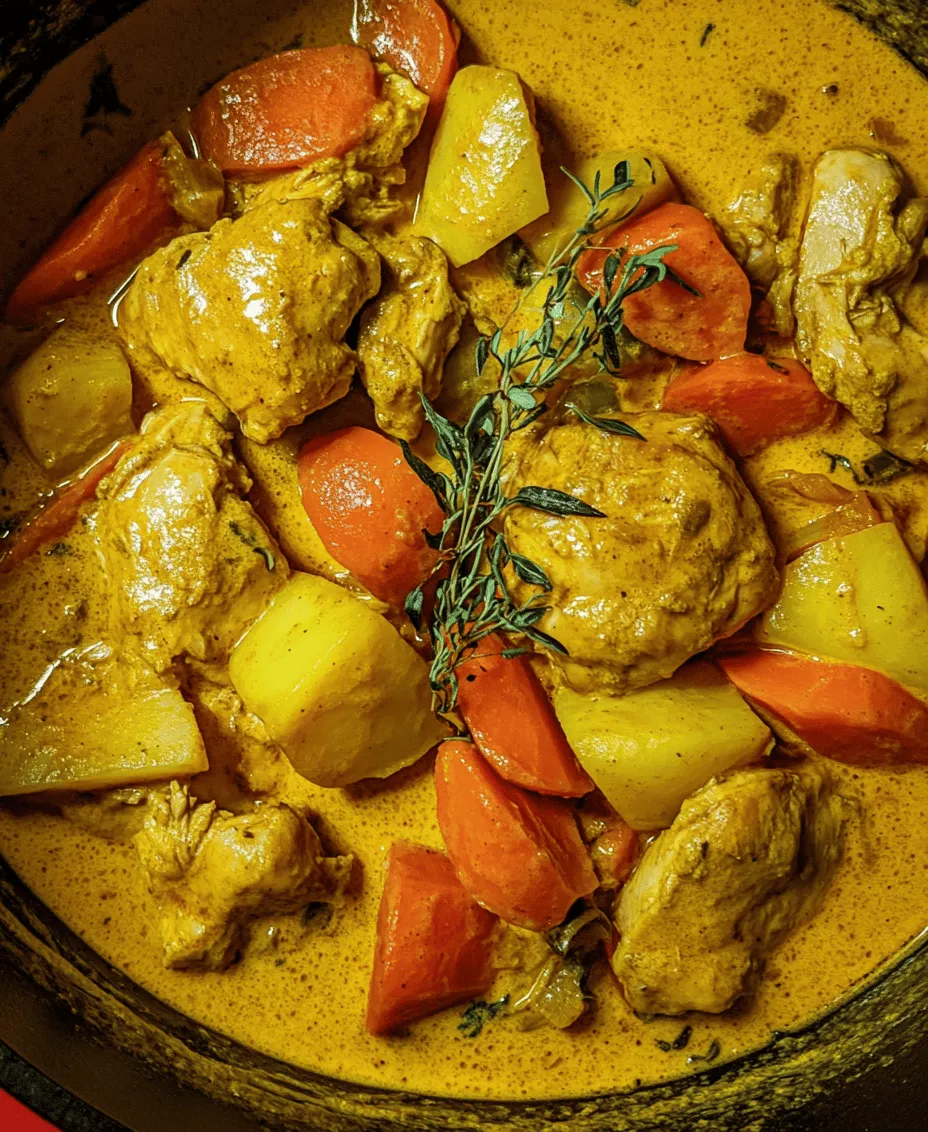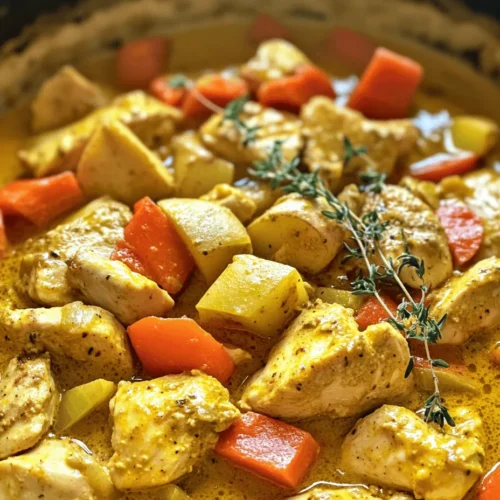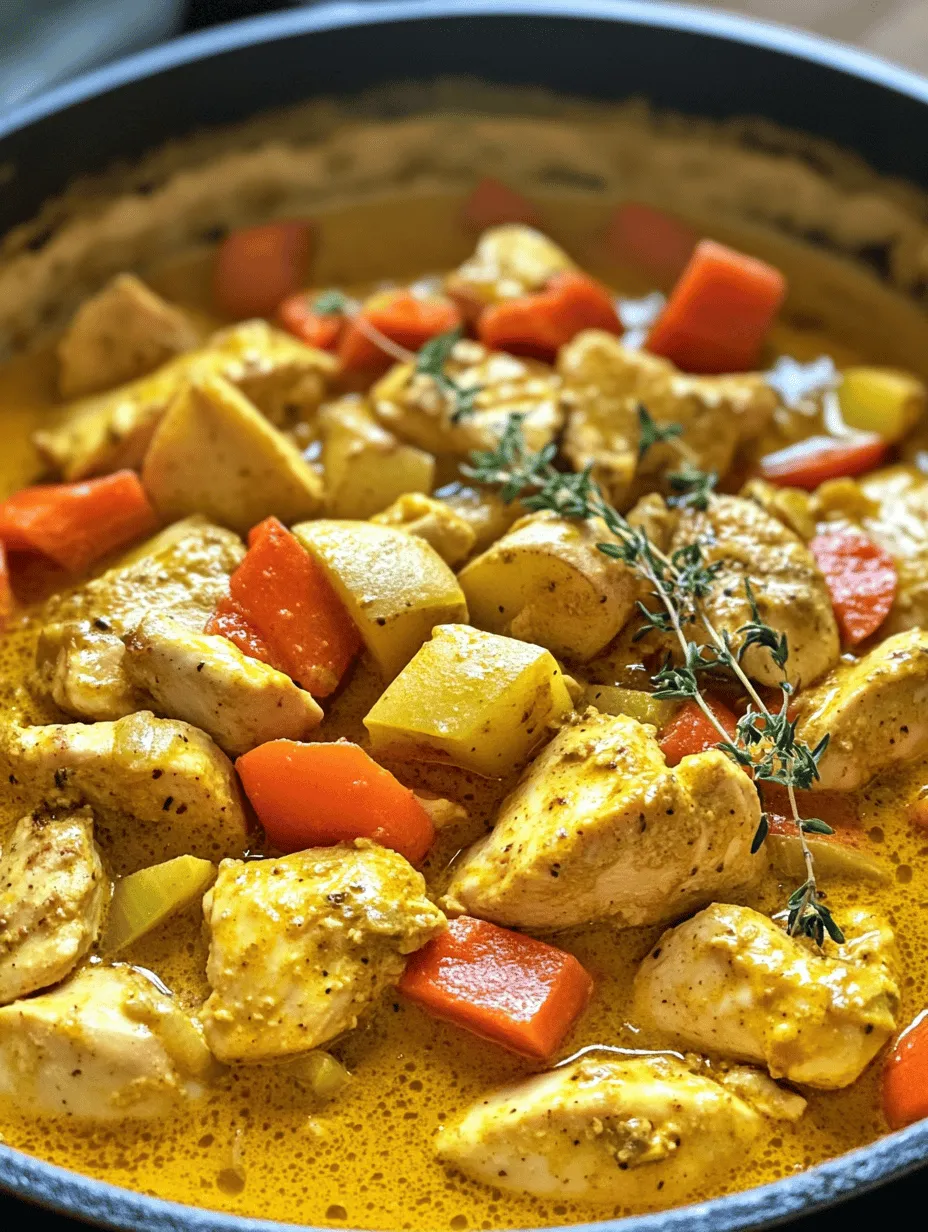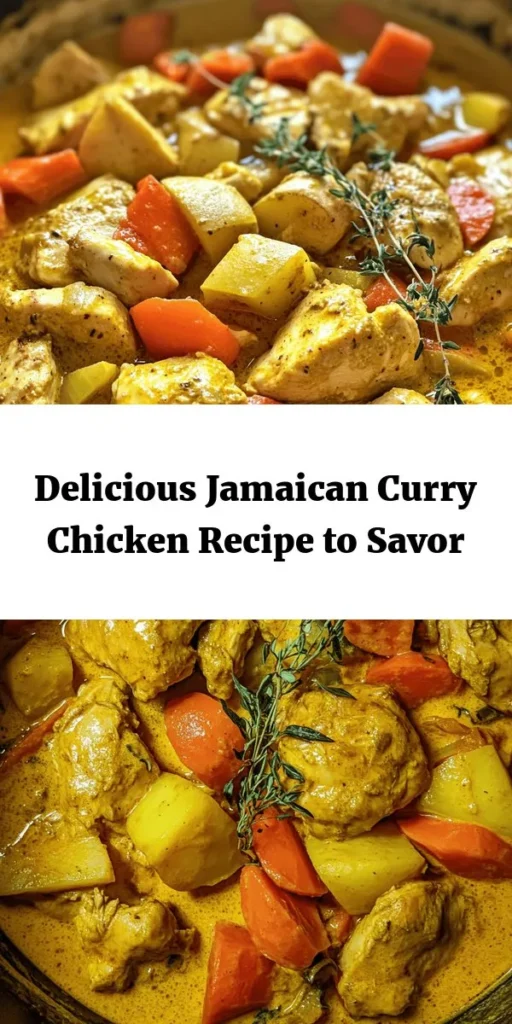Introduction
Jamaican cuisine is an exciting tapestry of flavors, aromas, and textures that reflect the island’s rich cultural heritage. With influences from African, Indian, and European cooking traditions, Jamaican food is characterized by its vibrant and bold seasonings. One dish that stands out among the many culinary treasures of Jamaica is curry chicken. This delectable dish is not just a staple in Jamaican households; it embodies the essence of island cooking and is loved for its comforting flavors and hearty ingredients.
Curry chicken holds a special place in the hearts of many Jamaicans. It is often served at family gatherings, celebrations, and Sunday dinners, making it a beloved comfort food. The dish is typically prepared with a blend of spices that offer a unique twist on traditional curry, showcasing Jamaica’s distinct culinary identity. What sets authentic Jamaican curry chicken apart is the careful selection of ingredients, each playing a crucial role in enhancing the dish’s flavors. From the spices to the herbs, using authentic Jamaican ingredients is essential for achieving the true taste of this dish.
One of the most appealing aspects of cooking Jamaican curry chicken is its relatively simple preparation process. Even novice cooks can master this recipe and impress family and friends with rich, complex flavors. The combination of marinated chicken, aromatic spices, and fresh vegetables creates a symphony of taste that is both satisfying and rewarding. In the following sections, we will delve deeper into the essentials of Jamaican curry chicken, exploring its origins, key ingredients, and preparation steps that will guide you to make an authentic dish right in your kitchen.
Understanding the Essentials of Jamaican Curry Chicken
Origins of Curry Chicken in Jamaican Culture
The origins of curry chicken in Jamaican cuisine can be traced back to the 19th century when Indian indentured laborers arrived on the island. They brought with them their culinary traditions, including the use of various spices and cooking techniques. Over time, these influences melded with local Jamaican ingredients and flavors, giving rise to a unique version of curry that has become an integral part of Jamaican culture. Today, curry chicken is not only a popular dish but also a symbol of Jamaica’s rich multicultural heritage.
In Jamaican households, curry chicken is often made for special occasions, such as family gatherings or festive celebrations, but it also serves as a comforting weeknight meal. The dish’s versatility allows it to be paired with a variety of sides, from rice and peas to fried plantains, making it a well-rounded option for any table.
Key Spices That Define Jamaican Curry
At the heart of Jamaican curry chicken is a blend of spices that create its distinctive flavor profile. The primary spices include:
– Curry Powder: While many cultures have their own versions of curry powder, Jamaican curry powder is notably different. It typically contains a unique combination of turmeric, coriander, cumin, fenugreek, and black pepper, giving it a vibrant yellow color and a warm, aromatic flavor. The specific blend can vary among brands and households, contributing to the individuality of each curry chicken recipe.
– Allspice: Known locally as “pimento,” allspice is a key ingredient in Jamaican cooking. It adds a depth of flavor that is both sweet and savory, enhancing the overall taste of the curry. Allspice can be used in both whole and ground forms, and its warm notes complement the heat of the curry powder beautifully.
– Scotch Bonnet Pepper: For those who appreciate heat in their dishes, the Scotch bonnet pepper is a must. This small but potent pepper provides a unique fruity heat that is quintessential to Jamaican cuisine. When used in moderation, it adds a lively kick to the curry without overpowering the other flavors.
The Role of Each Ingredient in Enhancing Flavor and Texture
Every ingredient in Jamaican curry chicken serves a purpose, contributing to the dish’s overall flavor and texture. For instance, the chicken itself is the centerpiece, and its richness pairs well with the bold spices. The choice of chicken parts—often thighs or drumsticks—ensures that the meat remains juicy and tender during cooking.
Fresh herbs, such as thyme, play a vital role in adding freshness and brightness to the dish. Thyme is commonly used in Jamaican cooking, and its earthy notes complement the richness of the curry. Additionally, vegetables such as onions, garlic, and bell peppers create a flavorful base and add texture to the dish.
In essence, each component of Jamaican curry chicken works in harmony to create a balanced and satisfying meal, showcasing the art of Jamaican cooking.
Ingredients Breakdown
To make an authentic Jamaican curry chicken, it’s important to select the right ingredients. Here’s a detailed breakdown of what you’ll need:
Chicken Selection
When it comes to choosing the chicken for your curry, the cut matters. While you can technically use any part of the chicken, thighs and drumsticks are the most popular choices. Thighs are slightly fattier, which helps keep the meat tender and juicy during the cooking process. Drumsticks are also a great option, providing a satisfying bite and flavor. Both cuts absorb the spices well, ensuring that every piece is bursting with flavor.
Jamaican Curry Powder
One of the standout elements of Jamaican curry chicken is the use of Jamaican curry powder. This spice blend is not only aromatic but also has a unique flavor profile that sets it apart from typical curry powders found in other cuisines. When purchasing Jamaican curry powder, look for brands that are known for quality, as the freshness and blend of spices can greatly influence the dish’s final taste.
Allspice
Allspice is a quintessential spice in Jamaican cooking, and its presence in curry chicken contributes to the dish’s complexity. When using allspice, consider whether you want to use whole berries or ground allspice. Whole berries can be added to the pot while cooking, infusing the curry with their warm flavor, while ground allspice is often used in the marinade.
Fresh Herbs: The Significance of Thyme
Thyme is an essential herb in many Caribbean dishes, and it plays a crucial role in Jamaican curry chicken. Fresh thyme adds a fragrant aroma and a subtle earthiness that enhances the curry’s flavor. If possible, use fresh thyme rather than dried, as fresh herbs offer a more vibrant flavor profile.
Scotch Bonnet Pepper
The Scotch bonnet pepper is a hallmark of Jamaican cuisine, known for its fiery heat and fruity undertones. It’s important to handle this pepper with care; depending on your heat tolerance, you can adjust the quantity used in the recipe. For a milder version, you can include just half a pepper or remove the seeds. Conversely, if you love spice, feel free to add more.
Vegetables Used and Their Contributions to the Dish
The vegetables you choose for your curry chicken can enhance both the flavor and texture of the dish. Common additions include:
– Onions: Sautéed onions create a sweet and savory base for the curry, adding depth of flavor.
– Garlic and Ginger: Both ingredients are essential for building the aromatic foundation of the dish. Garlic adds a pungent flavor, while ginger provides a warm, zesty note.
– Bell Peppers: Sliced bell peppers add sweetness and color, making the dish visually appealing and flavorful.
– Carrots and Potatoes: These vegetables can be added for heartiness and to soak up the delicious curry sauce.
By carefully selecting and preparing these ingredients, you can create a truly authentic Jamaican curry chicken that is bursting with flavor and reflects the vibrant culinary traditions of Jamaica.
Preparation Steps
Now that we’ve covered the essential ingredients for Jamaican curry chicken, let’s dive into the preparation steps that will bring this dish to life.
Marinating the Chicken: Importance and Tips for Maximizing Flavor
Marinating the chicken is a crucial step in preparing Jamaican curry chicken. This process not only infuses the meat with flavor but also helps tenderize it. To create a marinade, combine Jamaican curry powder, allspice, salt, black pepper, fresh thyme, minced garlic, ginger, and chopped Scotch bonnet pepper in a bowl. You can also add a splash of vinegar or lime juice to enhance the flavor.
Coat the chicken pieces thoroughly with the marinade, ensuring every piece is well-covered. For best results, let the chicken marinate for at least 2 hours, but if time allows, marinating overnight in the refrigerator will yield even richer flavors.
Searing the Chicken: Techniques for Achieving the Perfect Brown
Once marinated, it’s time to sear the chicken. Heating a large pot or Dutch oven over medium-high heat, add a splash of oil—coconut oil is a great option for an authentic touch. Carefully add the marinated chicken pieces to the pot, ensuring not to overcrowd them.
Searing the chicken creates a beautiful golden-brown crust, enhancing the flavor through caramelization. Allow the chicken to cook undisturbed for a few minutes before flipping to achieve an even sear on all sides. Once browned, remove the chicken from the pot and set it aside. This step is essential, as it adds depth to the overall flavor of the curry.
Sautéing Aromatics: How Onion, Garlic, and Ginger Create a Flavor Base
With the chicken seared, it’s time to build the flavor base for the curry. In the same pot, add a bit more oil if needed, and toss in sliced onions. Sauté the onions until they are translucent and fragrant, releasing their natural sweetness.
Next, add minced garlic and ginger to the pot. These aromatics are critical in developing the dish’s flavor profile, providing warmth and complexity. Sauté everything for a couple of minutes until the garlic is golden and fragrant, but be careful not to burn it, as this can create a bitter taste.
Adding Vegetables: Timing and Method for Optimal Texture
Once your aromatics are sautéed, it’s time to incorporate the vegetables. Adding bell peppers, carrots, and any other vegetables you desire at this stage will allow them to soften and absorb the flavors of the curry. Sauté the vegetables for a few minutes until they start to soften but still retain some crunch—this will provide a pleasing texture in the final dish.
After the vegetables are tender, return the seared chicken to the pot, ensuring it is nestled among the vegetables. The next steps will involve simmering the chicken in liquid, allowing all the flavors to meld together beautifully.
By following these preparation steps, you will set the stage for a delicious and authentic Jamaican curry chicken that captures the essence of Jamaica’s vibrant culinary scene. As you continue with the recipe, the final cooking process will further enhance the flavors, resulting in a dish that is sure to impress.

Combining Ingredients: The Balance of Liquids for a Hearty Curry
Once your chicken is marinated and ready to go, it’s time to bring all the ingredients together for that signature Jamaican curry chicken flavor. Start by adding the marinated chicken to a large pot or Dutch oven over medium heat. You want to ensure the pot is hot enough to sear the chicken slightly, which adds depth to the flavor profile.
Next, pour in the coconut milk, which is a staple in many Caribbean dishes. This creamy liquid not only adds richness but also balances the spices, making the dish flavorful without being overwhelmingly hot. The amount of coconut milk you use can vary based on your personal preference; typically, one can (about 13.5 ounces) is sufficient for a family-sized portion.
Along with the coconut milk, incorporate your chicken broth or water to achieve the desired consistency. A good rule of thumb is to use enough liquid to just cover the chicken, as this will allow it to simmer perfectly without becoming too soupy. If you prefer a thicker curry, you may want to reduce the amount of broth or coconut milk slightly.
Add any remaining vegetables you plan to include, such as diced potatoes, carrots, or bell peppers. These not only enhance the flavor but also add nutrients and texture to your dish. Stir everything together gently, ensuring that the spices, chicken, and vegetables are well combined in the pot.
Simmering the Curry: Ideal Cooking Times for Tenderness and Flavor Melding
With all your ingredients now in the pot, it’s time to let the magic happen. Bring the mixture to a gentle boil over medium-high heat, then reduce the heat to low and cover the pot. The simmering process is crucial for allowing the flavors to meld together beautifully.
For optimal tenderness, let the curry simmer for at least 30 to 45 minutes. During this time, the chicken will absorb the spices, and the coconut milk will reduce slightly, thickening the sauce. If you’re using bone-in chicken pieces, you may want to extend the cooking time to about an hour for maximum flavor and tenderness. If you use boneless chicken breasts, be careful not to overcook them, as they can become dry.
Every 15 minutes or so, stir the curry gently to ensure it doesn’t stick to the bottom of the pot. You can also taste and adjust the seasoning, adding more salt or pepper if needed. For those who enjoy a bit of heat, consider adding a few slices of fresh Scotch bonnet pepper during the last 10 minutes of cooking. This will infuse the dish with a spicy kick without overwhelming the other flavors.
Serving Suggestions
Traditional Accompaniments for Jamaican Curry Chicken
Jamaican curry chicken is best enjoyed with traditional sides that complement its bold flavors. The most popular accompaniment is rice and peas, which is actually rice cooked with kidney beans, thyme, and coconut milk. This dish balances the spice of the curry with its creamy, mild flavors. Another classic pairing is steamed rice, which serves as a neutral base that allows the curry’s rich sauce to shine.
Ideas for Pairing with Rice and Peas or Steamed Rice
When serving your curry chicken, portion out a generous helping of rice and peas on each plate, then ladle the curry over the top. This allows the flavorful sauce to seep into the rice, creating a deliciously cohesive meal. For added texture, consider garnishing with freshly chopped green onions or cilantro right before serving.
If you’re in the mood for something a bit different, try serving the curry chicken with flatbreads, such as roti or naan. This offers a delightful way to scoop up the curry and can be especially fun for family-style dining.
Creative Twists on Serving: Making It a Meal or a Side Dish
For a unique twist, you could transform your Jamaican curry chicken into a hearty wrap. Take a warm tortilla, fill it with curry chicken, and add fresh veggies like shredded lettuce, diced tomatoes, and a drizzle of yogurt or a tangy sauce. This not only makes for a satisfying lunch option but also introduces an exciting fusion of flavors.
Alternatively, if you want to serve the curry chicken as a side dish, consider smaller portions alongside grilled meats or fish. The curry’s vibrant flavors can enhance a larger meal, providing an excellent contrast to milder dishes.
Cultural Significance of Curry Chicken in Jamaica
Jamaican curry chicken is more than just a dish; it’s a symbol of culture and community. Traditionally enjoyed during celebrations and family gatherings, this dish often graces tables during significant events such as weddings, birthdays, and festive holidays. Its rich flavors and satisfying texture make it a crowd-pleaser, bringing people together over hearty servings of comfort food.
The Evolution of the Recipe Through Generations
The recipe for Jamaican curry chicken has evolved over generations, influenced by the island’s diverse cultural history. Originating from Indian culinary traditions brought to Jamaica by indentured laborers, the dish has been adapted to include local ingredients and flavors. This cross-cultural exchange has led to a unique version of curry that resonates deeply with Jamaican identity.
As families pass down their recipes, each generation adds its own touch, whether it’s a secret ingredient or a slight variation in cooking technique. This evolution ensures that while the core of the dish remains the same, it continues to adapt and thrive, reflecting the living culture of Jamaica.
How Curry Chicken Reflects Jamaican History and Multicultural Influences
The significance of curry chicken extends beyond its taste; it embodies Jamaica’s rich history of multicultural influences. The blend of African, Indian, Chinese, and British culinary practices has created a vibrant food landscape. Curry chicken is a quintessential example of how these influences have merged, resulting in a dish that is distinctly Jamaican yet globally recognized.
In essence, enjoying curry chicken is not just about savoring a meal; it’s about celebrating the history and resilience of a nation that has embraced diverse cultures, creating a unique culinary identity.
Health Benefits of the Ingredients
Nutritional Profile of Chicken and Its Health Benefits
Chicken is a staple protein source in many diets, valued for its versatility and health benefits. It is rich in lean protein, which is essential for muscle growth and repair, making it an excellent choice for maintaining a healthy lifestyle. Moreover, chicken provides vital nutrients such as B vitamins, which play a crucial role in energy metabolism and brain function.
When preparing Jamaican curry chicken, opting for skinless chicken pieces can further reduce fat content while maintaining flavor. This makes it a great protein choice for those looking to enjoy hearty meals without excessive calories.
Benefits of Coconut Milk in Cooking and Its Role in a Balanced Diet
Coconut milk, another key ingredient in Jamaican curry chicken, is not just a flavorful addition; it also brings several health benefits. It is rich in medium-chain triglycerides (MCTs), which are known for promoting energy and weight management. Additionally, coconut milk contains essential nutrients, including vitamins C and E, which contribute to overall health.
Though it’s important to consume coconut milk in moderation due to its calorie density, it can be a nutritious part of a balanced diet when used thoughtfully.
Importance of Fresh Vegetables in Maintaining Health
Fresh vegetables are an integral part of Jamaican curry chicken, providing both flavor and nutrition. Ingredients like bell peppers, carrots, and onions not only enhance the taste but also contribute vitamins, minerals, and fiber to the dish. Eating a variety of colorful vegetables helps ensure a wide range of nutrients, promoting overall health and well-being.
Incorporating vegetables into your meals can help support a healthy digestive system, boost immunity, and reduce the risk of chronic diseases. Therefore, feel free to add your favorite vegetables to the curry, making it not only delicious but also packed with health benefits.
Common Variations and Adaptations
Exploring Regional Variations of Curry Chicken in Jamaica
While the classic Jamaican curry chicken recipe is beloved, regional variations exist across the island. Some areas might incorporate different spices or cooking methods. For instance, in certain coastal regions, a touch of lime juice is added for a zesty flavor that complements the spices. Others might use a combination of chicken and seafood, such as shrimp, to create a unique surf-and-turf curry.
Exploring these variations can be a delightful culinary adventure, allowing you to experience the diverse flavors that Jamaican cuisine has to offer.
Vegetarian or Vegan Adaptations of the Recipe
For those seeking plant-based options, Jamaican curry chicken can easily be adapted to suit vegetarian or vegan diets. Substitute the chicken with chickpeas, tofu, or tempeh, which can all absorb the delicious spices and coconut milk just as well.
Incorporating hearty vegetables like cauliflower, sweet potatoes, or eggplant can also create a satisfying dish while maintaining the essence of the original recipe. When making these adaptations, be sure to adjust cooking times accordingly to ensure all ingredients are tender and flavorful.
Tips for Adjusting Spice Levels to Suit Different Palates
One of the beautiful aspects of curry is its adaptability to different spice preferences. If you prefer a milder curry, reduce the amount of curry powder or omit any hot peppers. Conversely, for those who crave heat, consider adding more Scotch bonnet peppers or a dash of cayenne pepper to elevate the dish.
Always remember to taste as you go. This way, you can adjust the spices to suit your palate and those of your guests, ensuring everyone enjoys the meal.
Concluding Thoughts
Jamaican curry chicken is a dish that encapsulates the vibrancy of Jamaican culture, offering a delightful blend of spices and history in each bite. Its depth of flavor, comfort, and connection to family traditions make it a must-try for anyone looking to explore Caribbean cuisine.
As you embark on this culinary journey, don’t hesitate to immerse yourself in the process. Cooking is an art that brings joy and connection, whether you’re preparing a meal for yourself or sharing it with loved ones.
So gather your ingredients, follow the steps, and experience the authentic taste of Jamaica right in your own kitchen. With every spoonful, you’ll not only savor the flavors but also appreciate the rich cultural heritage that makes this dish so special. Enjoy the process of cooking and the joy that comes from sharing delicious meals with those you cherish.



